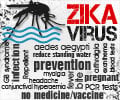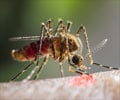New method of Zika virus detection developed using viral proteins attached to gold nanoparticles.
Highlights:
- Zika virus disease is a mosquito borne viral infection predominant in tropical and subtropical parts of the world.
- Currently available Zika detection tests take days with added necessity of cold storage and transport of blood.
- New study proposes a 15 minute, low-cost, paper based plasmonic assay for Zika virus detection.
Zika virus is a mosquito-borne flavivirus that has recently been reported to spread, causing a global health problem. The Zika virus is carried by the Aedes aegypti mosquito, a common carrier of dengue fever and yellow fever. Zika virus infection in pregnant women has a strong link to babies being born with microcephaly (small head circumference). It also causes Guillain-Barre syndrome; a nerve damaging disease resulting in muscle weakness, in adults. Most adults affected with the disease do not show any symptoms, which makes the infection difficult to detect and hence harder to treat and contain the disease.
The infection spreads when an infected mosquito bites or when a mosquito bites an infected person and further transmits the disease to unaffected people. There have been cases of spreading through semen and also saliva. There is presently no vaccine or cure available for Zika virus infections.
Current Zika virus detection tests
Since vaccination and cure are still far away, the ultimate approach to contain the disease is early detection, which will facilitate early treatment, and early counseling in case of infected expectant mothers. However, current tests for Zika virus detection require that the blood is refrigerated and transported to a central laboratory for testing. The test results are obtained days after testing. This delays diagnosis and possible treatment.
The new, rapid, low-cost, plasmonic based assay
A research team at Washington University has developed a test that quickly detects the presence of Zika virus in blood. Zika virus currently flourishes in warm and humid regions like South and Central America, Asia and Africa, all of which are resource limited in terms of refrigeration. This new method was developed keeping in mind of these parts of the world that require assays for detection that remain stable in both room and elevated temperatures.
The test relies on a protein made by Zika virus called the Zika virus non-structural protein 1 (NS1), which causes an immune response in infected individuals. Infected individuals produce anti-NS1 antibodies upon recognizing the viral NS1. These antibodies may be detected up to 1 month after the infection, thus giving the detection process a one-month window.
When the test needs to be conducted, the nano-crystals are removed by rinsing the nano-particle mounted paper with an acidic solution. This exposes the gold nanoparticles to react with the sample blood when dropped onto the surface. If the person is infected with the virus, the blood will contain anti-NS1 antibodies that will react with the NS1 protein attached to the gold nanoparticles. If there is a reaction, a slight color change is observed using a spectrophotometer, which indicates that the blood is infected with Zika virus. The test results are obtained within 15 minutes.
Future advancements
- Facilitating the reaction color change to be detected with the naked eye.
- Using saliva samples instead of blood.
- Morrissey, J., Jiang, Q., Chandar, Y., Cao, S., Kharasch, E., & Singamaneni, S. (2017). Rapid, point-of-care, thermally stable paper-based plasmonic assay for Zika virus diagnosis. Advanced Photonics (2017 (IPR, NOMA, Sensors, Networks, SPPCom, PS). doi:10.1364/sensors.2017.setu1e.2
Source-Medindia
















